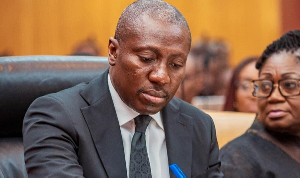The Bank of Ghana Monetary Policy Committee (MPC) on Monday, January 29, 2024, announced a cut in the key policy rate of 100 basis points, from 30% to 29%. This sounds like a big joke.
It is hard to imagine what impact our BOG officials expect a 1% reduction from 30% to make on lending rates, inflation rates, exchange rates or economic growth, let alone what they expect to learn or observe from it. I wonder whether they have determined the correlation between interest rates, inflation and exchange rates in our country.
The hesitant 1% rate cut to 29% is particularly surprising given their expectation that headline inflation would “ease to 15%±2% by the end of 2024 and gradually trend back to within the medium-term target range of 8%±2% by 2025”. I do not see the relationship between the expected or target 15%±2% inflation and the high 29% monetary policy rate. It gives the impression that our top economists do not believe in themselves or their own forecasts.
More worrying is the possibility that they do not believe in their own numbers, given their new claim of signs of “emerging recovery”, having previously told us that the economy had “turned the corner”.
Policy rate and open market operations
A central bank’s policy rate and open market operations are supposed to influence the rate of inflation. But BOG officials still have a fixation on headline or year-on-year inflation, and so cannot depart from their reactionary monetary policy approach, which responds to what had transpired, that is, past one-year price changes, instead of their expectation of inflation (15%±2% this year). So, the 1% reduction in the policy rate appears to be a reaction to the 3.2% fall in headline inflation in December to 23.2%%, from 26.4% % in November.
Thus, the key rate that commercial banks use as a reference for lending has been reduced to 29% after being pegged at 30% for six months. It is also invariably the reference rate for the Government’s domestic borrowing, setting a limit to the Government’s ability to exploit its power as the largest borrower.
BOG often talked about “mopping up excess liquidity” without defining what was optimal. But an interest rate policy that results in 30% plus return to money market investors is itself responsible for the delivery of “excess liquidity”.
Read more from the document below.
Opinions of Thursday, 29 February 2024
Columnist: Togbe Afede XIV















